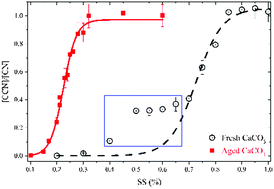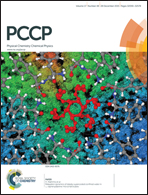Cloud condensation nucleation activities of calcium carbonate and its atmospheric ageing products
Abstract
Aerosol particles can serve as cloud condensation nuclei (CCN) to form cloud droplets, and its composition is a main factor governing whether an aerosol particle is an effective CCN. Pure mineral dust particles are poor CCN; however, changes in chemical composition of mineral dust aerosol particles, due to heterogeneous reactions with reactive trace gases in the troposphere, can modify their CCN properties. In this study we investigated the CCN activities of CaCO3 (as a surrogate for mineral dust) and its six atmospheric ageing products: Ca(NO3)2, CaCl2, CaSO4, Ca(CH3SO3)2, Ca(HCOO)2, and Ca(CH3COO)2. CaCO3 has a very low CCN activity with a hygroscopicity parameter (κ) of 0.001–0.003. The CCN activities of its potential atmospheric ageing products are significantly higher. For example, we determined that Ca(NO3)2, CaCl2 and Ca(HCOO)2 have κ values of ∼0.50, similar to that of (NH4)2SO4. Ca(CH3COO)2 has slightly lower CCN activity with a κ value of ∼0.40, and the κ value of CaSO4 is around 0.02. We further show that exposure of CaCO3 particles to N2O5 at 0% relative humidity (RH) significantly enhances their CCN activity, with κ values increasing to around 0.02–0.04. Within the experimental uncertainties, it appears that the variation in exposure to N2O5 from ∼550 to 15 000 ppbv s does not change the CCN activities of aged CaCO3 particles. This observation indicates that the CaCO3 surface may be already saturated at the shortest exposure. We also discussed the atmospheric implications of our study, and suggested that the rate of change in CCN activities of mineral dust particles in the troposphere is important to determine their roles in cloud formation.


 Please wait while we load your content...
Please wait while we load your content...